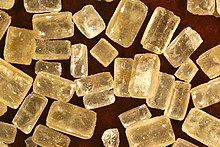Sugarcane
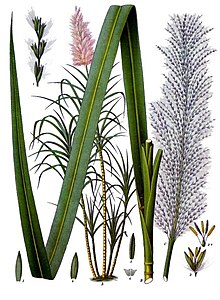
Sugarcane or sugar cane is a species of tall, perennial grass (in the genus Saccharum, tribe Andropogoneae) that is used for sugar production. The plants are 2–6 m (6–20 ft) tall with stout, jointed, fibrous stalks that are rich in sucrose,[1] which accumulates in the stalk internodes. Sugarcanes belong to the grass family, Poaceae, an economically important flowering plant family that includes maize, wheat, rice, and sorghum, and many forage crops. It is native to the warm temperate and tropical regions of India, Southeast Asia, and New Guinea.
Sugarcane was an ancient crop of the Austronesian and Papuan people. It was introduced to Polynesia, Island Melanesia, and Madagascar in prehistoric times via Austronesian sailors. It was also introduced to southern China and India by Austronesian traders around 1200 to 1000 BC. The Persians and Greeks encountered the famous "reeds that produce honey without bees" in India between the sixth and fourth centuries BC. They adopted and then spread sugarcane agriculture.[2] Merchants began to trade in sugar, which was considered a luxurious and expensive spice, from India. In the 18th century, sugarcane plantations began in the Caribbean, South American, Indian Ocean, and Pacific island nations. The need for sugar crop laborers became a major driver of large migrations, some people voluntarily accepting indentured servitude[3] and others forcibly imported as slaves.[4]
Grown in tropical and subtropical regions, sugarcane is the world's largest crop by production quantity, totalling 1.9 billion tonnes in 2020, with Brazil accounting for 40% of the world total. Sugarcane accounts for 79% of sugar produced globally (most of the rest is made from sugar beets). About 70% of the sugar produced comes from Saccharum officinarum and its hybrids.[5] All sugarcane species can interbreed, and the major commercial cultivars are complex hybrids.[6]
White sugar is produced from sugarcane in specialized mill factories. Sugarcane reeds are used to make pens, mats, screens, and thatch. The young, unexpanded flower head of Saccharum edule (duruka) is eaten raw, steamed, or toasted, and prepared in various ways in Southeast Asia, such as certain island communities of Indonesia as well as in Oceanic countries like Fiji.[7] The direct use of sugar cane to produce ethanol for biofuel is projected to potentially surpass the production of white sugar as an end product.
Etymology
[edit]The term 'sugarcane' is a combination of two words; sugar and cane. The former ultimately derives from Sanskrit शर्करा (śárkarā) as the crop originated in Southeast Asia. As sugar was traded and spread West, this became سُكَّر (sukkar) in Arabic, zúcchero in Italian, zuccarum in Latin, and eventually sucre in both Middle French and Middle English. The second term "cane" began to be used alongside it as the crop was grown on plantations in the Caribbean. Ganna is the Hindi word for sugarcane.[citation needed]
Characteristics
[edit]
Sugarcane, a perennial tropical grass, exhibits a unique growth pattern characterized by lateral shoots emerging at its base, leading to the development of multiple stems. These stems typically attain a height of 3 to 4 meters (approximately 10 to 13 feet) and possess a diameter of about 5 centimeters (approximately 2 inches). As these stems mature, they evolve into cane stalks, constituting a substantial portion of the entire plant, accounting for roughly 75% of its composition.[citation needed]
A fully mature cane stalk generally comprises a composition of around 11–16% fiber, 12–16% soluble sugars, 2–3% nonsugar carbohydrates, and 63–73% water content. The successful cultivation of sugarcane hinges on a delicate interplay of several factors, including climatic conditions, soil properties, irrigation methods, fertilization practices, pest and disease management, the selection of specific varieties, and the timing of the harvest.[citation needed]
In terms of yield, the average production of cane stalk stands at 60–70 tonnes per hectare (equivalent to 24–28 long tons per acre or 27–31 short tons per acre) annually. However, this yield figure is not fixed and can vary significantly, ranging from 30 to 180 tonnes per hectare. This variance is contingent upon the level of knowledge applied and the approach to crop management embraced in the cultivation of sugarcane. Ultimately, the successful cultivation of this valuable crop demands a thoughtful integration of various factors to optimize its growth and productivity.[citation needed]
Sugarcane is a cash crop, but it is also used as livestock fodder.[8] Sugarcane genome is one of the most complex plant genomes known, mostly due to interspecific hybridization and polyploidization.[9][10]
-
Cut sugarcane
-
Sugarcane canopy
History
[edit]The two centers of domestication for sugarcane are one for Saccharum officinarum by Papuans in New Guinea and another for Saccharum sinense by Austronesians in Taiwan and southern China. Papuans and Austronesians originally primarily used sugarcane as food for domesticated pigs. The spread of both S. officinarum and S. sinense is closely linked to the migrations of the Austronesian peoples. Saccharum barberi was only cultivated in India after the introduction of S. officinarum.[11][12]

S. officinarum was first domesticated in New Guinea and the islands east of the Wallace Line by Papuans, where it is the modern center of diversity. Beginning around 6,000 BP, several strains were selectively bred from the native Saccharum robustum. From New Guinea, it spread westwards to Maritime Southeast Asia after contact with Austronesians, where it hybridized with Saccharum spontaneum.[12]
The second domestication center is mainland southern China and Taiwan, where S. sinense was a primary cultigen of the Austronesian peoples. Words for sugarcane are reconstructed as *təbuS or *CebuS in Proto-Austronesian, which became *tebuh in Proto-Malayo-Polynesian. It was one of the original major crops of the Austronesian peoples from at least 5,500 BP. Introduction of the sweeter S. officinarum may have gradually replaced it throughout its cultivated range in maritime Southeast Asia.[14][15][13][16][17]

From Island Southeast Asia, S. officinarum was spread eastward into Polynesia and Micronesia by Austronesian voyagers as a canoe plant by around 3,500 BP. It was also spread westward and northward by around 3,000 BP to China and India by Austronesian traders, where it further hybridized with S. sinense and S. barberi. From there, it spread further into western Eurasia and the Mediterranean.[12][13]
The earliest known production of crystalline sugar began in northern India. The earliest evidence of sugar production comes from ancient Sanskrit and Pali texts.[19][20][21][22] Around the eighth century, Muslim and Arab traders introduced sugar from medieval India to the other parts of the Abbasid Caliphate in the Mediterranean, Mesopotamia, Egypt, North Africa, and Andalusia. By the 10th century, sources state that every village in Mesopotamia grew sugarcane.[18] It was among the early crops brought to the Americas by the Spanish, mainly Andalusians, from their fields in the Canary Islands, and the Portuguese from their fields in the Madeira Islands. An article on sugarcane cultivation in Spain is included in Ibn al-'Awwam's 12th-century Book on Agriculture.[23]
In colonial times, sugar formed one side of the triangle trade of New World raw materials, along with European manufactured goods, and African slaves. Christopher Columbus first brought sugarcane to the Caribbean (and the New World) during his second voyage to the Americas, initially to the island of Hispaniola (modern day Haiti and the Dominican Republic). The first sugar harvest happened in Hispaniola in 1501; many sugar mills were constructed in Cuba and Jamaica by the 1520s.[24] The Portuguese introduced sugarcane to Brazil. By 1540, there were 800 cane sugar mills in Santa Catarina Island and another 2,000 on the north coast of Brazil, Demarara, and Suriname.[citation needed]
Sugar, often in the form of molasses, was shipped from the Caribbean to Europe or New England, where it was used to make rum. The profits from the sale of sugar were then used to purchase manufactured goods, which were then shipped to West Africa, where they were bartered for slaves. The slaves were then brought back to the Caribbean to be sold to sugar planters. The profits from the sale of the slaves were then used to buy more sugar, which was shipped to Europe. Toil in the sugar plantations became a main basis for a vast network of forced population movement, supplying people to work under brutal coercion.
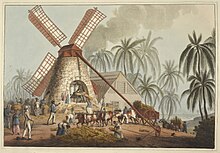
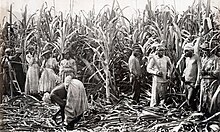
The passage of the 1833 Slavery Abolition Act led to the abolition of slavery through most of the British Empire, and many of the emancipated slaves no longer worked on sugarcane plantations when they had a choice. West Indian planters, therefore, needed new workers, and they found cheap labour in China and India.[25][26] The people were subject to indenture, a long-established form of contract, which bound them to unfree labour for a fixed term. The conditions where the indentured servants worked were frequently abysmal, owing to a lack of care among the planters.[27] The first ships carrying indentured labourers from India left in 1836.[28] The migrations to serve sugarcane plantations led to a significant number of ethnic Indians, Southeast Asians, and Chinese people settling in various parts of the world.[29] In some islands and countries, the South Asian migrants now constitute between 10 and 50% of the population. Sugarcane plantations and Asian ethnic groups continue to thrive in countries such as Fiji, South Africa, Myanmar, Sri Lanka, Malaysia, Indonesia, the Philippines, Guyana, Jamaica, Trinidad, Martinique, French Guiana, Guadeloupe, Grenada, St. Lucia, St. Vincent, St. Kitts, St. Croix, Suriname, Nevis, and Mauritius.[28][30]

Between 1863 and 1900, merchants and plantation owners in Queensland and New South Wales (now part of the Commonwealth of Australia) brought between 55,000 and 62,500 people from the South Pacific Islands to work on sugarcane plantations. An estimated one-third of these workers were coerced or kidnapped into slavery (known as blackbirding). Many others were paid very low wages. Between 1904 and 1908, most of the 10,000 remaining workers were deported in an effort to keep Australia racially homogeneous and protect white workers from cheap foreign labour.[31]
Cuban sugar derived from sugarcane was exported to the USSR, where it received price supports and was ensured a guaranteed market. The 1991 dissolution of the Soviet state forced the closure of most of Cuba's sugar industry.
Sugarcane remains an important part of the economy of Cuba, Guyana, Belize, Barbados, and Haiti, along with the Dominican Republic, Guadeloupe, Jamaica, and other islands.
About 70% of the sugar produced globally comes from S. officinarum and hybrids using this species.[5]

Cultivation
[edit]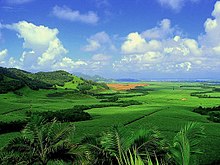



Sugarcane cultivation requires a tropical or subtropical climate, with a minimum of 60 cm (24 in) of annual moisture. It is one of the most efficient photosynthesizers in the plant kingdom. It is a C4 plant, able to convert up to 1% of incident solar energy into biomass.[32] In primary growing regions across the tropics and subtropics, sugarcane crops can produce over 15 kg/m2 of cane.
Sugar cane accounted for around 21% of the global crop production over the 2000–2021 period. The Americas was the leading region in the production of sugar cane (52% of the world total).[33]
Once a major crop of the southeastern region of the United States, sugarcane cultivation declined there during the late 20th century, and is primarily confined to small plantations in Florida, Louisiana, and southeast Texas in the 21st century. Sugarcane cultivation ceased in Hawaii when the last operating sugar plantation in the state shut down in 2016.[34]
Sugarcane is cultivated in the tropics and subtropics in areas with a plentiful supply of water for a continuous period of more than 6–7 months each year, either from natural rainfall or through irrigation. The crop does not tolerate severe frosts. Therefore, most of the world's sugarcane is grown between 22°N and 22°S, and some up to 33°N and 33°S.[35] When sugarcane crops are found outside this range, such as the Natal region of South Africa, it is normally due to anomalous climatic conditions in the region, such as warm ocean currents that sweep down the coast. In terms of altitude, sugarcane crops are found up to 1,600 m or 5,200 ft close to the equator in countries such as Colombia, Ecuador, and Peru.[36]
Sugarcane can be grown on many soils ranging from highly fertile, well-drained mollisols, through heavy cracking vertisols, infertile acid oxisols and ultisols, peaty histosols, to rocky andisols. Both plentiful sunshine and water supplies increase cane production. This has made desert countries with good irrigation facilities such as Egypt some of the highest-yielding sugarcane-cultivating regions. Sugarcane consumes 9% of the world's potash fertilizer production.[37]
Although some sugarcanes produce seeds, modern stem cutting has become the most common reproduction method.[38] Each cutting must contain at least one bud, and the cuttings are sometimes hand-planted. In more technologically advanced countries, such as the United States and Australia, billet planting is common. Billets (stalks or stalk sections) harvested by a mechanical harvester are planted by a machine that opens and recloses the ground. Once planted, a stand can be harvested several times; after each harvest, the cane sends up new stalks, called ratoons.[39] Successive harvests give decreasing yields, eventually justifying replanting. Two to 10 harvests are usually made depending on the type of culture. In a country with a mechanical agriculture looking for a high production of large fields, as in North America, sugarcanes are replanted after two or three harvests to avoid a lowering yields. In countries with a more traditional type of agriculture with smaller fields and hand harvesting, as in the French island of Réunion, sugarcane is often harvested up to 10 years before replanting.[citation needed]
Sugarcane is harvested by hand and mechanically. Hand harvesting accounts for more than half of production, and is dominant in the developing world. In hand harvesting, the field is first set on fire. The fire burns up dry leaves, and chases away or kills venomous snakes, without harming the stalks and roots. Harvesters then cut the cane just above ground-level using cane knives or machetes. A skilled harvester can cut 500 kg (1,100 lb) of sugarcane per hour.[failed verification][40]
Mechanical harvesting uses a combine, or sugarcane harvester.[41] The Austoft 7000 series, the original modern harvester design, has now been copied by other companies, including Cameco / John Deere.[citation needed] The machine cuts the cane at the base of the stalk, strips the leaves, chops the cane into consistent lengths and deposits it into a transporter following alongside. The harvester then blows the trash back onto the field. Such machines can harvest 100 long tons (100 t) each hour, but harvested cane must be rapidly processed. Once cut, sugarcane begins to lose its sugar content, and damage to the cane during mechanical harvesting accelerates this decline. This decline is offset because a modern chopper harvester can complete the harvest faster and more efficiently than hand cutting and loading. Austoft also developed a series of hydraulic high-lift infield transporters to work alongside its harvesters to allow even more rapid transfer of cane to, for example, the nearest railway siding. This mechanical harvesting does not require the field to be set on fire; the residue left in the field by the machine consists of cane tops and dead leaves, which serve as mulch for the next planting.
Pests
[edit]The cane beetle (also known as cane grub) can substantially reduce crop yield by eating roots; it can be controlled with imidacloprid (Confidor) or chlorpyrifos (Lorsban). Other important pests are the larvae of some butterfly/moth species, including the turnip moth, the sugarcane borer (Diatraea saccharalis), the African sugarcane borer (Eldana saccharina), the Mexican rice borer (Eoreuma loftini), the African armyworm (Spodoptera exempta), leafcutter ants, termites, spittlebugs (especially Mahanarva fimbriolata and Deois flavopicta), and Migdolus fryanus (a beetle). The planthopper insect Eumetopina flavipes acts as a virus vector, which causes the sugarcane disease ramu stunt.[42][43] Sesamia grisescens is a major pest in Papua New Guinea and so is a serious concern for the Australian industry were it to cross over.[44] To head off such a problem, the Federal Government has pre-announced that they would cover 80% of response costs if it were necessary.[44]
Pathogens
[edit]Numerous pathogens infect sugarcane, such as sugarcane grassy shoot disease caused by Candidatus Phytoplasma sacchari,[45] whiptail disease or sugarcane smut, pokkah boeng caused by Fusarium moniliforme, Xanthomonas axonopodis bacteria causes Gumming Disease, and red rot disease caused by Colletotrichum falcatum. Viral diseases affecting sugarcane include sugarcane mosaic virus, maize streak virus, and sugarcane yellow leaf virus.[46]
Yang et al., 2017 provides a genetic map developed for USDA ARS-run breeding programs for brown rust of sugarcane.[47]
Nitrogen fixation
[edit]Some sugarcane varieties are capable of fixing atmospheric nitrogen in association with the bacterium Gluconacetobacter diazotrophicus.[48] Unlike legumes and other nitrogen-fixing plants that form root nodules in the soil in association with bacteria, G. diazotrophicus lives within the intercellular spaces of the sugarcane's stem.[49][50] Coating seeds with the bacteria was assayed in 2006 with the intention of enabling crop species to fix nitrogen for its own use.[51]
Conditions for sugarcane workers
[edit]At least 20,000 people are estimated to have died of chronic kidney disease in Central America in the past two decades – most of them sugarcane workers along the Pacific coast. This may be due to working long hours in the heat without adequate fluid intake.[52] Additionally, some of the workers are being exposed to hazards such as: high temperatures, harmful pesticides, and poisonous or venomous animals. This occurs during the process of cutting the sugarcane manually, causing physical ailments due to constant repetitive movements for hours every work day.[53]
Processing
[edit]Traditionally, sugarcane processing requires two stages. Mills extract raw sugar from freshly harvested cane and "mill-white" sugar is sometimes produced immediately after the first stage at sugar-extraction mills, intended for local consumption. Sugar crystals appear naturally white in color during the crystallization process. Sulfur dioxide is added to inhibit the formation of color-inducing molecules and to stabilize the sugar juices during evaporation.[54][55] Refineries, often located nearer to consumers in North America, Europe, and Japan, then produce refined white sugar, which is 99% sucrose. These two stages are slowly merging. Increasing affluence in the sugarcane-producing tropics increases demand for refined sugar products, driving a trend toward combined milling and refining.[56]
Milling
[edit]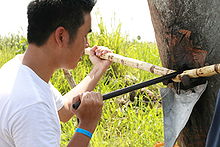

Sugarcane processing produces cane sugar (sucrose) from sugarcane. Other products of the processing include bagasse, molasses, and filtercake.
Bagasse, the residual dry fiber of the cane after cane juice has been extracted, is used for several purposes:[57]
- fuel for the boilers and kilns
- production of paper, paperboard products, and reconstituted panelboard
- agricultural mulch
- as a raw material for production of chemicals
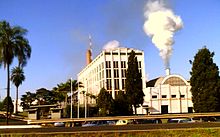
The primary use of bagasse and bagasse residue is as a fuel source for the boilers in the generation of process steam in sugar plants. Dried filtercake is used as an animal feed supplement, fertilizer, and source of sugarcane wax.[citation needed]
Molasses is produced in two forms: blackstrap, which has a characteristic strong flavor, and a purer molasses syrup. Blackstrap molasses is sold as a food and dietary supplement. It is also a common ingredient in animal feed, and is used to produce ethanol, rum, and citric acid. Purer molasses syrups are sold as molasses, and may also be blended with maple syrup, invert sugars, or corn syrup. Both forms of molasses are used in baking.[citation needed]
Refining
[edit]This article needs additional citations for verification. (October 2020) |
Sugar refining further purifies the raw sugar. It is first mixed with heavy syrup and then centrifuged in a process called "affination". Its purpose is to wash away the sugar crystals' outer coating, which is less pure than the crystal interior. The remaining sugar is then dissolved to make a syrup, about 60% solids by weight.
The sugar solution is clarified by the addition of phosphoric acid and calcium hydroxide, which combine to precipitate calcium phosphate. The calcium phosphate particles entrap some impurities and absorb others, and then float to the top of the tank, where they can be skimmed off. An alternative to this "phosphatation" technique is "carbonatation", which is similar, but uses carbon dioxide and calcium hydroxide to produce a calcium carbonate precipitate.
After filtering any remaining solids, the clarified syrup is decolorized by filtration through activated carbon. Bone char or coal-based activated carbon is traditionally used in this role.[58] Some remaining color-forming impurities are adsorbed by the carbon. The purified syrup is then concentrated to supersaturation and repeatedly crystallized in a vacuum, to produce white refined sugar. As in a sugar mill, the sugar crystals are separated from the molasses by centrifuging. Additional sugar is recovered by blending the remaining syrup with the washings from affination and again crystallizing to produce brown sugar. When no more sugar can be economically recovered, the final molasses still contains 20–30% sucrose and 15–25% glucose and fructose.
To produce granulated sugar, in which individual grains do not clump, sugar must be dried, first by heating in a rotary dryer, and then by blowing cool air through it for several days.
Ribbon cane syrup
[edit]Ribbon cane is a subtropical type that was once widely grown in the Southern United States, as far north as coastal North Carolina. The juice was extracted with horse- or mule-powered crushers; the juice was boiled, like maple syrup, in a flat pan, and then used in the syrup form as a food sweetener.[59] It is not currently a commercial crop, but a few growers find ready sales for their product.[citation needed]

Production
[edit]| Top Sugarcane producers | |
|---|---|
| in 2022 | |
| Numbers in million tonnes | |
| 1. | 724.4 (37.69%) |
| 2. | 439.4 (22.86%) |
| 3. | 103.4 (5.38%) |
| 4. | 92.1 (4.79%) |
| 5. | 88 (4.58%) |
| 6. | 55.3 (2.88%) |
| 7. | 35 (1.82%) |
| 8. | 32.4 (1.69%) |
| 9. | 31.5 (1.64%) |
| 10. | 28.7 (1.49%) |
| World total | 1,922.1 |
| Source: FAOSTAT[61] | |
In 2022, global production of sugarcane was 1.92 billion tonnes, with Brazil producing 38% of the world total, India with 23%, and China producing 5% (table).
Worldwide, 26 million hectares were devoted to sugarcane cultivation in 2020.[61] The average worldwide yield of sugarcane crops in 2022 was 74 tonnes per hectare, led by Peru with 121 tonnes per hectare.[61] The theoretical possible yield for sugarcane is about 280 tonnes per hectare per year, and small experimental plots in Brazil have demonstrated yields of 236–280 tonnes of cane per hectare.[62][63]
From 2008 to 2016, production of standards-compliant sugarcane experienced a compound annual growth rate of about 52%, while conventional sugarcane increased at less than 1%.[64]
Environmental impacts
[edit]Soil degradation and erosion
[edit]The cultivation of sugarcane can lead to increased soil loss through the removal of soil at harvest, as well as improper irrigation practices, which can result in erosion.[65][66] Erosion is especially significant when the sugarcane is grown on slopes or hillsides, which increases the rate of water runoff.[65][66] Generally, it is recommended that sugarcane is not planted in areas with a slope greater than 8%.[65] However, in certain areas, such as parts of the Caribbean and South Africa, slopes greater than 20% have been planted.[65] Increased erosion can lead to the removal of organic and nutrient-rich material, which can decrease future crop yields. It can also result in sediments and other pollutants being washed into aquatic habitats, which can result in a wide range of environmental issues, including eutrophication and acidification.[65][66]
Sugarcane cultivation can also result in soil compaction, which is caused by the use of heavy, infield machinery.[65] Along with impacting invertebrate and fauna within the upper layers of the soil, compaction can also lead to decreased porosity.[65][66] This in turn can increase surface runoff, resulting in greater leaching and erosion.[65]
Habitat destruction
[edit]
Due to the large quantity of water required, sugarcane cultivation heavily relies on irrigation.[67] Additionally, since large amounts of soil are removed with the crop during harvest, significant washing occurs during the processing phase.[67] In many countries, such as India and Australia, this requirement has placed a strain on available resources, requiring the construction of barrages and other dams.[65][67] This has altered the amount of water reaching aquatic habitats, and has contributed to the degradation of ecosystems such as the Great Barrier Reef and Indus Delta.[65][67]

Sugarcane has also contributed to habitat destruction through the clearance of land.[65] Seven countries around the world devote more than 50% of their land to the cultivation of sugarcane.[65] Sugarcane fields have replaced tropical rain forests and wetlands.[65] While the majority of this clearance occurred in the past, expansions have occurred within the past couple decades, further contributing to habitat destruction.[66]
Mitigation efforts
[edit]A wide variety of mitigation efforts can be implemented to reduce the impacts of sugarcane cultivation.[65] Among these efforts is switching to alternative irrigation techniques, such as drip irrigation, which are more water efficient.[65] Water efficiency can also be improved by employing methods such as trash mulching, which has been shown to increase water intake and storage.[65][68] Along with reducing the overall water use, this method can also decrease soil runoff, and therefore prevent pollutants from entering the environment.[65] In areas with a slope greater than 11%, it is also recommended that zero tillage or cane strip planting are implemented to help prevent soil loss.[65]
Sugarcane processing produces a wide variety of pollutants, including heavy metals and bagasse, which can be released into the environment through wastewater discharge.[65] To prevent this, alternative treatment methods such as high rate anaerobic digestions can be implemented to better treat this wastewater.[69] Stormwater drains can also be installed to prevent uncontrolled runoff from reaching aquatic ecosystems.[65]
Ethanol
[edit]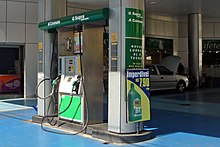
Ethanol is generally available as a byproduct of sugar production. It can be used as a biofuel alternative to gasoline, and is widely used in cars in Brazil. It is an alternative to gasoline, and may become the primary product of sugarcane processing, rather than sugar[citation needed]
In Brazil, gasoline is required to contain at least 22% bioethanol.[70] This bioethanol is sourced from Brazil's large sugarcane crop.
The production of ethanol from sugarcane is more energy efficient than from corn or sugar beets or palm/vegetable oils, particularly if cane bagasse is used to produce heat and power for the process. Furthermore, if biofuels are used for crop production and transport, the fossil energy input needed for each ethanol energy unit can be very low. EIA estimates that with an integrated sugarcane to ethanol technology, the well-to-wheels CO2 emissions can be 90% lower than conventional gasoline.[70] A textbook on renewable energy[71] describes the energy transformation:
Presently, 75 tons of raw sugarcane are produced annually per hectare in Brazil. The cane delivered to the processing plant is called burned and cropped (b&c), and represents 77% of the mass of the raw cane. The reason for this reduction is that the stalks are separated from the leaves (which are burned and whose ashes are left in the field as fertilizer), and from the roots that remain in the ground to sprout for the next crop. Average cane production is, therefore, 58 tons of b&c per hectare per year.
Each ton of b&c yields 740 kg of juice (135 kg of sucrose and 605 kg of water) and 260 kg of moist bagasse (130 kg of dry bagasse). Since the lower heating value of sucrose is 16.5 MJ/kg, and that of the bagasse is 19.2 MJ/kg, the total heating value of a ton of b&c is 4.7 GJ of which 2.2 GJ come from the sucrose and 2.5 from the bagasse.
Per hectare per year, the biomass produced corresponds to 0.27 TJ. This is equivalent to 0.86 W per square meter. Assuming an average insolation of 225 W per square meter, the photosynthetic efficiency of sugar cane is 0.38%.
The 135 kg of sucrose found in 1 ton of b&c are transformed into 70 litres of ethanol with a combustion energy of 1.7 GJ. The practical sucrose-ethanol conversion efficiency is, therefore, 76% (compare with the theoretical 97%).
One hectare of sugar cane yields 4,000 litres of ethanol per year (without any additional energy input, because the bagasse produced exceeds the amount needed to distill the final product). This, however, does not include the energy used in tilling, transportation, and so on. Thus, the solar energy-to-ethanol conversion efficiency is 0.13%.
Bagasse applications
[edit]
Sugarcane is a major crop in many countries. It is one of the plants with the highest bioconversion efficiency. Sugarcane crop is able to efficiently fix solar energy, yielding some 55 tonnes of dry matter per hectare of land annually. After harvest, the crop produces sugar juice and bagasse, the fibrous dry matter. This dry matter is biomass with potential as fuel for energy production. Bagasse can also be used as an alternative source of pulp for paper production.[72]
Sugarcane bagasse is a potentially abundant source of energy for large producers of sugarcane, such as Brazil, India, and China. According to one report, with use of latest technologies, bagasse produced annually in Brazil has the potential of meeting 20% of Brazil's energy consumption by 2020.[73]
Electricity production
[edit]A number of countries, in particular those lacking fossil fuels, have implemented energy conservation and efficiency measures to minimize the energy used in cane processing, and export any excess electricity to the grid. Bagasse is usually burned to produce steam, which in turn creates electricity. Current technologies, such as those in use in Mauritius, produce over 100 kWh of electricity per tonne of bagasse. With a total world harvest of over one billion tonnes of sugarcane per year, the global energy potential from bagasse is over 100,000 GWh.[74] Using Mauritius as a reference, an annual potential of 10,000 GWh of additional electricity could be produced throughout Africa.[75] Electrical generation from bagasse could become quite important, particularly to the rural populations of sugarcane producing nations.
Recent cogeneration technology plants are being designed to produce from 200 to over 300 kWh of electricity per tonne of bagasse.[76][77] As sugarcane is a seasonal crop, shortly after harvest the supply of bagasse would peak, requiring power generation plants to strategically manage the storage of bagasse.
Biogas production
[edit]A greener alternative to burning bagasse for the production of electricity is to convert bagasse into biogas. Technologies are being developed to use enzymes to transform bagasse into advanced biofuel and biogas.[73]
Sugarcane as food
[edit]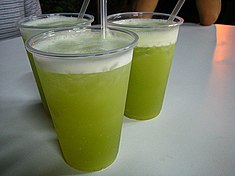 Freshly squeezed sugarcane juice | |
| Nutritional value per 100 grams | |
|---|---|
| Energy | 242 kJ (58 kcal) |
13.11 g | |
| Sugars | 12.85 g |
| Dietary fiber | 0.56 g |
0.40 | |
0.16 g | |
| Vitamins | Quantity %DV† |
| Vitamin B6 | 24% 0.40 mg |
| Folate (B9) | 11% 44.53 μg |
| Vitamin C | 7% 6.73 mg |
| Minerals | Quantity %DV† |
| Calcium | 1% 18 mg |
| Iron | 6% 1.12 mg |
| Magnesium | 3% 13.03 mg |
| Phosphorus | 2% 22.08 mg |
| Potassium | 5% 150 mg |
| Sodium | 0% 1.16 mg |
| Zinc | 1% 0.14 mg |
Nutrient Information from Indian Food Composition Database | |
| †Percentages estimated using US recommendations for adults,[79] except for potassium, which is estimated based on expert recommendation from the National Academies.[80] | |
In most countries where sugarcane is cultivated, several foods and popular dishes are derived directly from it, such as:
- Raw sugarcane: chewed to extract the juice
- Sayur nganten: an Indonesian soup made with the stem of trubuk (Saccharum edule), a type of sugarcane
- Sugarcane juice: a combination of fresh juice, extracted by hand or small mills, with a touch of lemon and ice to make a popular drink, known variously as air tebu, usacha rass, guarab, guarapa, guarapo, papelón, aseer asab, ganna sharbat, mosto, caldo de cana, or nước mía
- Syrup: a traditional sweetener in soft drinks worldwide but now largely supplanted in the US by high fructose corn syrup, which is less expensive because of corn subsidies and sugar tariffs[81]
- Molasses: used as a sweetener and a syrup accompanying other foods, such as cheese or cookies
- Jaggery: a solidified molasses, known as gur, gud, or gul in modern Indo-Aryan, is traditionally produced by evaporating juice to make a thick sludge, and then cooling and molding it in buckets. Modern production partially freeze dries the juice to reduce caramelization and lighten its color. It is used as sweetener in cooking traditional entrees, sweets, and desserts.
- Falernum: a sweet, and slightly alcoholic drink made from sugarcane juice
- Cachaça: the most popular distilled alcoholic beverage in Brazil; it is a liquor made of the distillation of sugarcane juice.
- Rum is a liquor made from sugarcane products, typically molasses, but sometimes also cane juice. It is most commonly produced in the Caribbean and environs.
- Basi is a fermented alcoholic beverage made from sugarcane juice produced in the Philippines and Guyana.
- Panela, solid pieces of sucrose and fructose obtained from the boiling and evaporation of sugarcane juice, is a food staple in Colombia and other countries in South and Central America.
- Rapadura is a sweet flour that is one of the simplest refinings of sugarcane juice, common in Latin American countries such as Brazil, Argentina, and Venezuela (where it is known as papelón) and the Caribbean.
- Rock candy: crystallized cane juice
- Gâteau de Sirop
- Viche, a homebrewed Colombian alcoholic beverage
Sugarcane as feed
[edit]Many parts of the sugarcane are commonly used as animal feeds where the plants are cultivated. The leaves make a good forage for ruminants.[82]
Gallery
[edit]-
Sugarcane flowering
-
Flowers of sugarcane
-
Evaporator with baffled pan and foam dipper for making ribbon cane syrup
-
A video of sugarcane juice extraction
-
Caipirinha, a cocktail made from sugarcane-derived cachaça
See also
[edit]- Sugar plantations in the Caribbean
- Sugar plantations in Hawaii
- Sugar industry of the Philippines
- Trapiche
References
[edit]- ^ Papini-Terzi, Flávia S.; Rocha, Flávia R.; Vêncio, Ricardo ZN; Felix, Juliana M.; Branco, Diana S.; Waclawovsky, Alessandro J.; Del Bem, Luiz EV; Lembke, Carolina G.; Costa, Maximiller DL; Nishiyama, Milton Y.; Vicentini, Renato (21 March 2009). "Sugarcane genes associated with sucrose content". BMC Genomics. 10 (1): 120. doi:10.1186/1471-2164-10-120. ISSN 1471-2164. PMC 2666766. PMID 19302712.
- ^ "Agribusiness Handbook: Sugar beet white sugar" (PDF). Food and Agriculture Organization, United Nations. 2009. Archived from the original (PDF) on 5 September 2015. Retrieved 6 February 2012.
- ^ "Indian indentured labourers". The National Archives, Government of the United Kingdom. 2010. Archived from the original on 20 September 2019. Retrieved 15 April 2022.
- ^ Mintz, Sidney (1986). Sweetness and Power: The Place of Sugar in Modern History. Penguin. ISBN 978-0-14-009233-2.
- ^ Jump up to: a b "Plants & Fungi: Saccharum officinarum (sugar cane)". Royal Botanical Gardens, Kew. Archived from the original on 4 June 2012.
- ^ Vilela, Mariane de Mendonça; Del-Bem, Luiz-Eduardo; Van Sluys, Marie-Anne; De Setta, Nathalia; Kitajima, João Paulo; et al. (2017). "Analysis of Three Sugarcane Homo/Homeologous Regions Suggests Independent Polyploidization Events of Saccharum officinarum and Saccharum spontaneum". Genome Biology and Evolution. 9 (2): 266–278. doi:10.1093/gbe/evw293. PMC 5381655. PMID 28082603.
- ^ "Consumer Preference for Indigenous Vegetables" (PDF). World Agroforestry Centre. 2009. Archived (PDF) from the original on 4 February 2015. Retrieved 7 February 2012.
- ^ Perez, Rena (1997). "Chapter 3: Sugar cane". Feeding pigs in the tropics. Food and Agriculture Organization of the United Nations. Archived from the original on 21 February 2018. Retrieved 2 September 2018.
- ^ Vicentini, R.; Del Bem, L. E. V.; Van Sluys, M. A.; Nogueira, F. T. S.; Vincentz, M. (1 June 2012). "Gene Content Analysis of Sugarcane Public ESTs Reveals Thousands of Missing Coding-Genes and an Unexpected Pool of Grasses Conserved ncRNAs". Tropical Plant Biology. 5 (2): 199–205. doi:10.1007/s12042-012-9103-z. ISSN 1935-9764. S2CID 2986185.
- ^ Vilela, Mariane de Mendonça; Del Bem, Luiz Eduardo; Van Sluys, Marie-Anne; de Setta, Nathalia; Kitajima, João Paulo; Cruz, Guilherme Marcelo Queiroga; Sforça, Danilo Augusto; de Souza, Anete Pereira; Ferreira, Paulo Cavalcanti Gomes; Grativol, Clícia; Cardoso-Silva, Claudio Benicio (1 February 2017). "Analysis of Three Sugarcane Homo/Homeologous Regions Suggests Independent Polyploidization Events of Saccharum officinarum and Saccharum spontaneum". Genome Biology and Evolution. 9 (2): 266–278. doi:10.1093/gbe/evw293. ISSN 1759-6653. PMC 5381655. PMID 28082603.
- ^ Daniels, John; Daniels, Christian (April 1993). "Sugarcane in Prehistory". Archaeology in Oceania. 28 (1): 1–7. doi:10.1002/j.1834-4453.1993.tb00309.x.
- ^ Jump up to: a b c Paterson, Andrew H.; Moore, Paul H.; Tom L., Tew (2012). "The Gene Pool of Saccharum Species and Their Improvement". In Paterson, Andrew H. (ed.). Genomics of the Saccharinae. Springer Science & Business Media. pp. 43–72. ISBN 9781441959478.
- ^ Jump up to: a b c Daniels, Christian; Menzies, Nicholas K. (1996). Needham, Joseph (ed.). Science and Civilisation in China: Volume 6, Biology and Biological Technology, Part 3, Agro-Industries and Forestry. Cambridge University Press. pp. 177–185. ISBN 9780521419994.
- ^ Blust, Robert (1984–1985). "The Austronesian Homeland: A Linguistic Perspective". Asian Perspectives. 26 (1): 44–67. hdl:10125/16918.
- ^ Spriggs, Matthew (2 January 2015). "Archaeology and the Austronesian expansion: where are we now?". Antiquity. 85 (328): 510–528. doi:10.1017/S0003598X00067910. S2CID 162491927.
- ^ Aljanabi, Salah M. (1998). "Genetics, phylogenetics, and comparative genetics of Saccharum L., a polysomic polyploid Poales: Andropogoneae". In El-Gewely, M. Raafat (ed.). Biotechnology Annual Review. Vol. 4. Elsevier Science B.V. pp. 285–320. ISBN 9780444829719.
- ^ Baldick, Julian (2013). Ancient Religions of the Austronesian World: From Australasia to Taiwan. I.B.Tauris. p. 2. ISBN 9780857733573.
- ^ Jump up to: a b Watson, Andrew (1983). Agricultural innovation in the early Islamic world. Cambridge University Press. pp. 26–27. ISBN 9780521247115
- ^ Watt, George (1893), The Economic Products of India, W. H. Allen & Co., Vol 6, Part II, pp. 29–30
- ^ Hill, J.A. (1902), The Anglo-American Encyclopedia, Vol. 7, p. 725
- ^ Luckey, Thomas D. (1973) CRC Handbook of Food Additives, 2nd edition, Furia, Thomas E. (ed.) Vol. 1, Ch. 1. p. 7. ISBN 978-0849305429
- ^ Snodgrass, Mary Ellen (2004) Encyclopedia of Kitchen History, Routledge, pp. 145–146. ISBN 978-1579583804
- ^ Ibn al-'Awwam, Yaḥyá (1864). Le livre de l'agriculture d'Ibn-al-Awam (kitab-al-felahah) (in French). Translated by J.-J. Clement-Mullet. Paris: A. Franck. pp. 365–367 (ch. 7 – Article 47). OCLC 780050566. (pp. 365–367 (Article XLVII)
- ^ Benitez-Rojo, Antonio (1996) [1992]. The Repeating Island. Durham: Duke University Press. p. 93. ISBN 978-0-8223-1865-1.
- ^ Lai, Walton (1993). Indentured labor, Caribbean sugar: Chinese and Indian migrants to the British West Indies, 1838–1918. Johns Hopkins University Press. ISBN 978-0-8018-7746-9.
- ^ Vertovik, Steven (1995). Robin Cohen (ed.). The Cambridge survey of world migration. Cambridge University Press. pp. 57–68. ISBN 978-0-521-44405-7.
- ^ Tinker, Hugh (1993). New System of Slavery. Hansib Publishing, London. ISBN 978-1-870518-18-5.
- ^ Jump up to: a b "Forced Labour". The National Archives, Government of the United Kingdom. 2010. Archived from the original on 4 December 2016. Retrieved 1 February 2012.
- ^ Laurence, K (1994). A Question of Labour: Indentured Immigration Into Trinidad & British Guiana, 1875–1917. St Martin's Press. ISBN 978-0-312-12172-3.
- ^ "St. Lucia's Indian Arrival Day". Caribbean Repeating Islands. 2009. Archived from the original on 24 April 2017. Retrieved 1 February 2012.
- ^ Flanagan, Tracey; Wilkie, Meredith; Iuliano, Susanna. "Australian South Sea Islanders: A century of race discrimination under Australian law". Australian Human Rights Commission. Archived from the original on 14 March 2011.
- ^ Whitmarsh, John (1999). "The Photosynthetic Process". In GS Singhal; G Renger; SK Sopory; K-D Irrgang; Govindjee (eds.). Concepts in Photobiology: Photosynthesis and Photomorphogenesis. Narosa Publishers/New Delhi and Kluwer Academic/Dordrecht. pp. 11–51. ISBN 978-9401060264. Archived from the original on 14 August 2010. Retrieved 4 January 2011.
- ^ World Food and Agriculture – Statistical Yearbook 2023 | FAO | Food and Agriculture Organization of the United Nations. 2023. doi:10.4060/cc8166en. ISBN 978-92-5-138262-2. Retrieved 13 December 2023.
{{cite book}}:|website=ignored (help) - ^ Solomon, Molly (17 December 2016). "The final days of Hawaiian sugar". US National Public Radio – Hawaii. Archived from the original on 21 October 2019. Retrieved 21 October 2019.
- ^ Rolph, George (1873). Something about sugar: its history, growth, manufacture and distribution. San Francisco, J. J. Newbegin.
- ^ Abhishek, Aditya (2021). "Sugarcane Farming: Complete Guide [to the] Farming of Sugarcane". Agriculture Review. Archived from the original on 16 April 2022. Retrieved 29 March 2022.
- ^ "What is potash?". www.uralkali.com. Archived from the original on 28 October 2020. Retrieved 10 December 2020.
- ^ Bassam, Nasir El (2010). Handbook of Bioenergy Crops: A Complete Reference to Species, Development and Applications. Earthscan. ISBN 9781849774789.
- ^ Tayyab, Muhammad; Yang, Ziqi; Zhang, Caifang; Islam, Waqar; Lin, Wenxiong; Zhang, Hua (1 September 2021). "Sugarcane monoculture drives microbial community composition, activity and abundance of agricultural-related microorganisms". Environmental Science and Pollution Research. 28 (35): 48080–48096. Bibcode:2021ESPR...2848080T. doi:10.1007/s11356-021-14033-y. ISSN 1614-7499. PMID 33904129. S2CID 233403664.
- ^ "Sugarcane". The Village: A Network Portal (Nepal). 2015. Archived from the original on 8 March 2022. Retrieved 29 March 2022.
- ^ "Sugar-Cane Harvester Cuts Forty-Tons an Hour". Popular Mechanics Monthly. Hearst Magazines. July 1930. Retrieved 2 April 2012.
- ^ Malein, Patrick. "How to find brand-new diseases of sugarcane!". Biological Sciences at Oxford. Archived from the original on 11 August 2007.
- ^ Odiyo, Peter Onyango (December 1981). "Development of the first outbreaks of the African armyworm, Spodoptera exempta (Walk.), between Kenya and Tanzania during the 'off-season' months of July to December". International Journal of Tropical Insect Science. 1 (4): 305–318. doi:10.1017/S1742758400000606. S2CID 85994702. Archived from the original on 12 December 2018. Retrieved 15 November 2017.
- ^ Jump up to: a b Goebel, Francois; Nader, Sallam (2011). "New pest threats for sugarcane in the new bioeconomy and how to manage them". Current Opinion in Environmental Sustainability. 3 (1–2). Elsevier BV: 81–89. Bibcode:2011COES....3...81G. doi:10.1016/j.cosust.2010.12.005. ISSN 1877-3435.
- ^ Kirdat, K; Tiwarekar, B; Thorat, V; Sathe, S; Shouche, Y; Yadav, A (January 2021). "'Candidatus Phytoplasma sacchari', a novel taxon - associated with Sugarcane Grassy Shoot (SCGS) disease". International Journal of Systematic and Evolutionary Microbiology. 71 (1). doi:10.1099/ijsem.0.004591. PMID 33289626. S2CID 227948269.
- ^ Gonçalves, Marcos; Pinto, Luciana; Creste, Silvana; Landell, Marcos (9 November 2011). "Virus Diseases of Sugarcane. A Constant Challenge to Sugarcane Breeding in Brazil". Functional Plant Science & Biotechnology. 6: 108–116.
- ^ Manimekalai, Ramaswamy; Suresh, Gayathri; Govinda, Hemaprabha; Athiappan, Selvi; Kandalam, Mallikarjuna (2020). "Role of NGS and SNP genotyping methods in sugarcane improvement programs". Critical Reviews in Biotechnology. 40 (6). Taylor & Francis (T&F): 865–880. doi:10.1080/07388551.2020.1765730. ISSN 0738-8551. PMID 32508157. S2CID 219537026.
- ^ Yamada, Y.; Hoshino, K.; Ishikawa, T. (1998). "Gluconacetobacter corrig.‡ (Gluconoacetobacter [sic]). In Validation of Publication of New Names and New Combinations Previously Effectively Published Outside the IJSB, List no. 64" (PDF). Int J Syst Bacteriol. 48 (1): 327–328. doi:10.1099/00207713-48-1-327. Retrieved 13 March 2020.
- ^ Dong, Z.; et al. (1994). "A Nitrogen-Fixing Endophyte of Sugarcane Stems (A New Role for the Apoplast)". Plant Physiology. 105 (4): 1139–1147. doi:10.1104/pp.105.4.1139. PMC 159442. PMID 12232271.
- ^ Boddey, R. M.; Urquiaga, S.; Reis, V.; Döbereiner, J. (November 1991). "Biological nitrogen fixation associated with sugar cane". Plant and Soil. 137 (1): 111–117. Bibcode:1991PlSoi.137..111B. doi:10.1007/BF02187441. S2CID 27437118.
- ^ Cocking, E. C.; Stone, P. J.; Davey, M. R. (2006). "Intracellular colonization of roots of Arabidopsis and crop plants by Gluconacetobacter diazotrophicus". In Vitro Cellular & Developmental Biology - Plant. 42: 74–82. doi:10.1079/IVP2005716. S2CID 24642832.
- ^ Lakhani, Nina (16 February 2015). "Nicaraguans demand action over illness killing thousands of sugar cane workers". The Guardian. Archived from the original on 8 April 2015. Retrieved 9 April 2015.
- ^ Leite, Rocha, Marceli. "Sugarcane cutting work, risks, and health effects: a literature review". Universidade de São Paulo. Faculdade de Saúde Pública.
{{cite web}}: Missing or empty|url=(help)CS1 maint: multiple names: authors list (link) - ^ Steindl, Roderick (2005). "Syrup Clarification for Plantation White Sugar to meet New Quality Standards" (PDF). In Hogarth, DM (ed.). Proceedings of the XXV Congress of International Society of Sugar Cane Technologists. Guatemala, Guatemala City. pp. 106–116.
- ^ "Home | CODEXALIMENTARIUS FAO-WHO". www.fao.org. Archived from the original on 31 December 2021. Retrieved 1 January 2022.
- ^ Flórez-Martínez, Diego Hernando; Contreras-Pedraza, Carlos Alberto; Rodríguez, Jader (1 January 2021). "A systematic analysis of non-centrifugal sugar cane processing: Research and new trends". Trends in Food Science & Technology. 107: 415–428. doi:10.1016/j.tifs.2020.11.011. ISSN 0924-2244. S2CID 228847326.
- ^ "Sugarcane processing" (PDF). Environmental Protection Agency, United States. 2005. Archived (PDF) from the original on 3 January 2012. Retrieved 2 February 2012.
- ^ Yacoubou, Jeanne (2007). "Is Your Sugar Vegan? An Update on Sugar Processing Practices" (PDF). Vegetarian Journal. Vol. 26, no. 4. pp. 15–19. Retrieved 4 April 2007.
- ^ Cowser, R. L. (January–March 1978). "Cooking Ribbon Cane Syrup". The Kentucky Folklore Record. Archived from the original on 19 November 2011. Retrieved 25 April 2012.
- ^ World Food and Agriculture – Statistical Yearbook 2021. Food and Agriculture Organization. 2021. p. 60. doi:10.4060/cb4477en. ISBN 978-92-5-134332-6. S2CID 240163091. Archived from the original on 3 November 2021. Retrieved 29 March 2022.
- ^ Jump up to: a b c "Sugar cane production in 2022, Crops/Regions/World list/Production Quantity/Year (pick lists)". UN Food and Agriculture Organization, Corporate Statistical Database (FAOSTAT). 2024. Retrieved 10 June 2024.
- ^ Bogden AV (1977). Tropical Pasture and Fodder Plants (Tropical Agriculture). Longman Group (Far East), Limited. ISBN 978-0582466760.
- ^ Duke, James (1983). "Saccharum officinarum L." Purdue University. Archived from the original on 6 June 2012. Retrieved 7 February 2012.
- ^ Voora, V.; Bermudez, S.; and Larrea, C. (2019). "Sugar Coverage". International Institute for Sustainable Development. Archived from the original on 20 March 2022. Retrieved 29 March 2022.
- ^ Jump up to: a b c d e f g h i j k l m n o p q r s t "Sugar and the Environment: Encouraging Better Management Practices in Sugar Production and Processing" (PDF). World Wide Fund for Nature. 1986. Archived (PDF) from the original on 27 March 2023. Retrieved 12 March 2023.
- ^ Jump up to: a b c d e Cheesman, Oliver (2004). Environmental Impacts of Sugar Production: The Cultivation and Processing of Sugarcane and Sugar Beet. United Kingdom: CABI Publishing. ISBN 0851999816.
- ^ Jump up to: a b c d "Sugarcane processing" (PDF). Environmental Protection Agency, United States. 2005. Archived (PDF) from the original on 3 January 2012. Retrieved 2 February 2012.
- ^ Prosdocimi, Massimo; Tarolli, Paolo; Cerdà, Artemi (1 October 2016). "Mulching practices for reducing soil water erosion: A review". Earth-Science Reviews. 161: 191–203. Bibcode:2016ESRv..161..191P. doi:10.1016/j.earscirev.2016.08.006. ISSN 0012-8252.
- ^ Fito, Jemal; Tefera, Nurelegne; Van Hulle, Stijn W. H. (28 March 2019). "Sugarcane biorefineries wastewater: bioremediation technologies for environmental sustainability". Chemical and Biological Technologies in Agriculture. 6 (1): 6. doi:10.1186/s40538-019-0144-5. hdl:1854/LU-8753281. ISSN 2196-5641.
- ^ Jump up to: a b "IEA Energy Technology Essentials: Biofuel Production" (PDF). International Energy Agency. 2007. Archived from the original (PDF) on 15 June 2010. Retrieved 1 February 2012.
- ^ da Rosa, A. (2005) Fundamentals of Renewable Energy Processes. Elsevier. pp. 501–502. ISBN 978-0-12-088510-7
- ^ Rainey, Thomas; Covey, Geoff; Shore, Dennis (December 2006). "An analysis of Australian sugarcane regions for bagasse paper manufacture". International Sugar Journal. 108 (1295): 640–644. Archived from the original on 1 January 2016. Retrieved 15 June 2015.
- ^ Jump up to: a b "Cetrel and Novozymes to Make Biogas and Electricity from Bagasse". Business Wire. 14 December 2009. Archived from the original on 12 May 2013. Retrieved 1 February 2012.
- ^ "Wade Report on Global Bagasse Cogeneration: High Efficiency Bagasse Cogeneration Can Meet Up To 25% of National Dower Demand in Cane Producing Countries" (PDF) (Press release). World Alliance for Decentralized Energy. 15 June 2004. Retrieved 13 March 2020.
Bagasse Cogen – Global Review and Potential (Report). World Alliance for Decentralized Energy. 2004. - ^ "Sugar Cane Bagasse Energy Cogeneration – Lessons from Mauritius" (PDF). The United Nations. 2005. Archived (PDF) from the original on 9 August 2017. Retrieved 29 June 2017.
- ^ "Steam economy and cogeneration in cane sugar factories" (PDF). International Sugar Journal. 92 (1099): 131–140. 1990. Archived from the original (PDF) on 24 December 2010.
- ^ Hollanda, Erber (2010). Trade and Environment Review. United Nations. pp. 68–80. ISBN 978-92-1-112782-9.
- ^ "Indian Food Composition Tables". National Institute of Nutrition, Indian Council of Medical Research. 2017. Archived from the original on 13 June 2020. Retrieved 13 June 2020.
- ^ United States Food and Drug Administration (2024). "Daily Value on the Nutrition and Supplement Facts Labels". FDA. Archived from the original on 27 March 2024. Retrieved 28 March 2024.
- ^ National Academies of Sciences, Engineering, and Medicine; Health and Medicine Division; Food and Nutrition Board; Committee to Review the Dietary Reference Intakes for Sodium and Potassium (2019). Oria, Maria; Harrison, Meghan; Stallings, Virginia A. (eds.). Dietary Reference Intakes for Sodium and Potassium. The National Academies Collection: Reports funded by National Institutes of Health. Washington, DC: National Academies Press (US). ISBN 978-0-309-48834-1. PMID 30844154. Archived from the original on 9 May 2024. Retrieved 21 June 2024.
- ^ Pollan M (12 October 2003). "The (Agri)Cultural Contradictions Of Obesity". The New York Times. Archived from the original on 16 September 2015. Retrieved 4 September 2015.
- ^ Heuzé, V.; Thiollet, H.; Tran, G.; Lebas, F. (5 July 2018). "Sugarcane forage, whole plant". Feedipedia, a programme by INRA, CIRAD, AFZ and FAO. Archived from the original on 12 December 2018. Retrieved 11 April 2019.
Sources
[edit]![]() This article incorporates text from a free content work. Licensed under CC BY-SA IGO 3.0 (license statement/permission). Text taken from World Food and Agriculture – Statistical Yearbook 2023, FAO, FAO.
This article incorporates text from a free content work. Licensed under CC BY-SA IGO 3.0 (license statement/permission). Text taken from World Food and Agriculture – Statistical Yearbook 2023, FAO, FAO.
External links
[edit]- Global sugar & sugar cane production stats from oecd.




